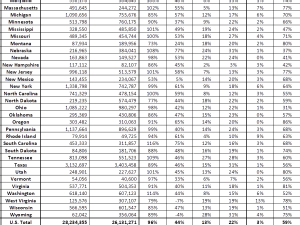Fitch Rates Triborough Bridge & Tunnel Authority’s (NY) General Rev Rfdg Bonds Ser 2017C at ‘AA-’
posted by AJOT | Oct 31 2017 at 07:40 AM | Intermodal
Fitch Ratings has assigned an 'AA-' rating to the Triborough Bridge and Tunnel Authority, NY's (TBTA) approximately $500 million in senior general revenue refunding bonds, series 2017C.The Rating Outlook is Stable.
KEY RATING DRIVERS
Summary: The 'AA-'rating reflects the bridge and tunnel system's essentiality to the New York metropolitan region, minimal demand elasticity, and demonstrated rate-making ability. Credit concerns include the system's dependence on revenue growth to subsidize the MTA's operations through annual transfers. These transfers continue to drain the system's liquidity and increase its dependence on future borrowing to fund its own sizable capital needs. TBTA's financial profile is expected to remain strong despite about $2.4 billion of forecasted borrowing through 2021 per the July 2017 financial plan to support future capital needs, evidenced by average rating case senior DSCR levels of 2.1x and senior leverage of 5.9x.
Revenue Risk - Volume: Stronger
CRITICAL ASSETS: The bridge and tunnel system provides vital transportation links in the New York metropolitan area and is important to the regional economy, evidenced by TBTA's resilient traffic base with relatively low volatility. TBTA's traffic base also benefits from minimal commercial exposure and limited competition despite some nearby un-tolled bridges. While toll rates are elevated, traffic has remained relatively inelastic to TBTA's frequent increases.
Revenue Risk - Price: Stronger
DEMONSTRATED TOLL INCREASES: TBTA benefits from unlimited legal flexibility to increase rates in excess of inflation and minimal political interference to rate increases. The authority also has a demonstrated history of rate increases, evidenced by eight rate hikes since 2002 and plans to continue to increase rates on a biannual basis.
Infrastructure Development/Renewal Risk: Weaker
LARGE DEBT-FUNDED CAPITAL PROGRAM: TBTA's five-year capital plan is large at $2.9 billion, primarily focusing on the system's conversion to open road tolling (ORT) and major maintenance of bridges, tunnels, and roadways. TBTA's legal requirement to transfer majority of its surplus revenues to MTA for operations impedes the authority's ability to meaningfully grow cash balances and leaves TBTA reliant on additional debt to fund capital expenditures. As such, the capital plan is expected to be 80% debt-funded with $2.3 billion in new money expected over the plan's cycle. The age and heavily travelled nature of the system necessitates continual rehabilitation.
Debt Structure Risk: Midrange (senior)
TRANSFER SUBORDINATION PROTECTS BONDHOLDERS: TBTA's debt structure is comprised of fully amortizing debt, with increasing debt service obligations until maximum annual debt service (MADS) is reached in 2032. The debt's variable-rate exposure is manageable at 6.7% on the senior lien. The absence of debt service reserve funds is a credit concern but partially mitigated by the presence of healthy unrestricted cash balances. The structural subordination of MTA transfers protects bondholders by ensuring high DSCRs.
Financial Metrics
HEALTHY FINANCIAL PROFILE: TBTA's senior DSCRs were strong in fiscal 2016 at 2.8x and are expected to remain strong at above 2x under rating case conditions. Senior leverage was low in fiscal 2016 at 4.3x, and could increase to nearly 6x under rating case conditions.
PEER GROUP
Bay Area Toll Authority (BATA; AA/Stable Outlook) is TBTA's closest peer. BATA has higher consolidated leverage at over 12x compared to roughly 6x for TBTA. However, BATA has a policy to maintain $1 billion in cash and investments, which provides significant liquidity to the authority. In contrast, TBTA's ability to build reserves is limited because the authority provides annual surplus transfers to MTA, causing TBTA to be more reliant on future toll increases to meet needs.
RATING SENSITIVITIES
Future Developments That May, Individually or Collectively, Lead to Negative Rating Action:
-Lower than anticipated revenue yields from planned toll increases and/or higher than anticipated expense growth which pressures senior DSCRs meaningfully below 2.0x for a sustained period.
-Additional borrowing that results in total leverage persistently above 8.0x.
-Significant reduction in reserve levels with no expectation of replenishment and an indication of continued deferred maintenance to sustain MTA transfers.
Future Developments That May, Individually or Collectively, Lead to Positive Rating Action:
-Given the size of the issuer's capital program and its constrained liquidity, upward rating movement is not likely in the near term.
TRANSACTION SUMMARY
TBTA expects to issue approximately $500 million of par in senior general revenue refunding bonds, series 2017C, to advance-refund certain outstanding TBTA bonds for economic savings. Proceeds will also cover the costs of issuance. The proposed refunding bonds are expected to be all fixed-rate and on parity with existing senior revenue bonds. The refunding bonds will reach final maturity in 2028, without extending the maturities of the refunded bonds.
Performance Update
Year-to-date traffic growth for the eight months of fiscal 2017 through August has been less favorable than fiscal 2016, declining by 0.3%, primarily as a result of construction approaching and at the Queens Midtown and Hugh L. Carey tunnels, which depressed traffic growth yoy. The impact of tunnel construction is expected to moderate through the remainder of fiscal 2017, with construction expected to be completed by 2018. Toll revenue has increased by 1.3% YTD, also reflective of increased E-ZPass participation, somewhat offset by the 4% toll increase implemented in March 2017.
Given YTD performance, Fitch expects traffic growth to be flat and toll revenue growth to be 2%, slightly below that of the toll increase of 4% in fiscal 2017. Tolls are expected to increase again by 4% in March 2019 and biannually thereafter, subject to TBTA board approval.










